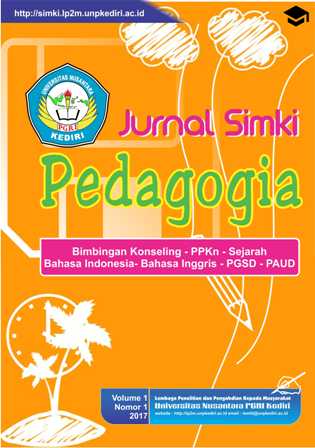AN ANALYSIS OF STUDENTS\' ANXIETY IN SPEAKING ENGLISH OF 10TH GRADE STUDENTS IN SMK PAWYATAN DAHA 1 KEDIRI
Author (Penulis)
IRAWATIUniversitas Nusantara PGRI Kediri
Author Identity (NPM)
14.1.01.08.0152Abstract
ABSTRACT
Speaking is the ability to produce articulation, sounds or sentences to express and idea or feeling. Mastering speaking is difficult for some students. When they should speak in front of class they feel anxious, nervous, lack of confident. Anxiety is the crucial factor which can impede students’ fluency in speaking English. The aims of this research are to find out the students’ anxiety level, to find the factors that can cause students’ anxiety in speaking and the strategies to reduce anxiety. This research used mix method with sequential explanatory design. The instruments of this research were questionnaire, interview and documentation. The researcher conducted the research at 10th grade students of Hospitality Accommodation in SMK Pwayatan Daha 1 Kediri. The data were analyzed using SPSS 23.0. The data questionnaire showed that the students who got low level were (0%), moderate level (82%), and high level (12%). And from 3 factors, the most influencial factor was fear of negative evaluation (65,7%) and others were test anxiety (64,2%), and communication apprehension (63,8%). In addition, the data interview showed that students who got high anxiety had many strategies to reduce his/her anxiety in speaking English than the students who got low/moderate anxiety. In brief, from the data finding, students need more attention from the teacher. In order the students feel pleasant in the class and do not feel anxious in speaking class.
Keyword
aReference
BIBLIOGRAPHY
Nunan, D. 2000. Language Teaching Methodology. Oxford: Phoenix.
Nunan, D. 2003. Practical English Language Teaching. 1st Ed. New York: McGraw-Hill.
Brown, H. D. (2007). Principles of Language Learning and Teaching. 5th ed. United States of America: Pearson Longman.
Pekrun, R. & Linnenbrink-Garcia, L. (Eds.). 2014. International Handbook of Emotions in Education. Routledge.
Young, D. J. 1999. Affect in Foreign Language and Second Language Learning: A Practical Guide to Creating a Low-Anxiety Classroom Atmosphere. Boston: McGraw-Hill.
Horwitz, E. K., Horwitz, M. B., & Cope, J. 1986. Foreign language classroom anxiety. Modern Language Journal, 70, 125–132.
Dornyei, Z. 2005. The psychology of the language learner: Individual differences in second language acquisition. Mahwah, NJ, Lawrence Erlbaum.
Cresswell, J, W. 2003. Research Design: Qualitative, Quantitative, and Mixed Method Approaches 2nd Ed. Thousand Oaks, CA: Sage Publications Inc.
Ary, D., Jacobs, Sorensen & Razavieh, A. 2010. Introduction to research in Education. 8th Edition. US: Thomson Wadsworth Inc.
Oda, H. 2011. The Effect of Anxiety on Learning English as Foreign Language. No. 58. Journal of The Collage of Arts. University of Basrah.
Sahin, D. 2016. Secondary and High School Students’ Anxiety: A Comparative Study. Thesis of Master Degree. Eastern Mediterranian University.
